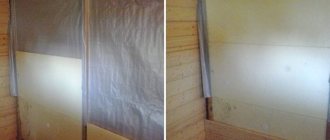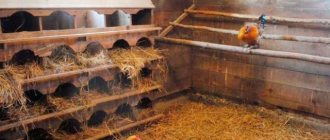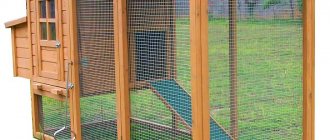1 273
no comments yet
0
Author of the article
Rasskazov Pavel
Reading time: 2 minutes
Chickens are unpretentious poultry, however, their maintenance in winter should be approached with all responsibility in order to avoid losses of livestock and their egg production.
The correct temperature in the chicken coop will help create suitable living conditions and will not affect the well-being and health of the chickens in winter, as well as their productivity.
What temperature do chickens need outside and in the coop?
What temperature does a chicken need in winter is not as simple a question as it seems. Of course, there are average figures for Russia in general. Experts and practicing farmers say that the optimal temperature in the chicken coop is about 23 - 25 degrees. This ensures a stable release of eggs in quantities comparable to the summer season. Egg production will decrease significantly at 15 degrees above zero. At plus five you no longer have to wait for fresh eggs.
The bird itself tolerates sub-zero temperatures (down to minus 8 - 10), but subject to certain conditions. Walking is possible if there is no wind or precipitation outside, the snow has been removed, it is advisable to walk under a canopy and for a short time.
Staying outside for a long time in frosts of 10 degrees or below can lead to frostbite on your comb and earrings. For walking at this temperature, it is recommended to lubricate them with grease or Vaseline.
Important. Sudden changes in temperature are just as harmful to birds as just low temperatures. This must be taken into account both in the poultry house and when going for a walk from plus 25 degrees to minus 10 degrees outside.
At what temperature do chickens lay eggs?
There are clear temperature limits at which egg production of chickens is maintained. Maximum productivity is observed when the temperature in the poultry house is maintained from +23 to +25 degrees.
Note: In summer it will not be difficult to maintain the temperature at the optimal level, but in winter you will have to install heating devices in the poultry house. Suitable heating options will be discussed below.
If the temperature in the poultry house drops below +15 degrees, the egg production of birds decreases, and at +5 degrees it stops completely.
What determines the endurance of chickens in winter?
There are serious debates on Internet forums about how many degrees chickens can withstand in winter, and it’s not surprising. After all, the comfortable existence and degree of egg production of chickens depend on many factors:
- from the breed of bird;
- from age;
- general well-being;
- on living conditions and proper feeding.
With age, everything is more or less clear - first-year chickens lay eggs well, with general well-being too - in a clean, spacious house with careful care, the chickens are calm and comfortable.
But what breed to choose and what conditions a farmer needs to create for a successful business is worth considering in more detail.
Temperature range to keep chickens calm
First, let's figure out what temperature chickens can withstand. This indicator depends on the type of bird. And it ranges from -10 to +27 degrees.
At high temperatures, the shells of eggs will become thinner. Their mass becomes smaller. And the number is decreasing. Not to mention that when exposed to heat for a long time, birds drink a lot and eat little. This means they don’t gain weight. In addition, chickens can get heatstroke.
At low temperatures, birds can freeze their paws, wattles and combs. And due to extreme cold, he will catch a cold and die.
On the other hand, there is an opinion that healthy and well-fed chickens tolerate cold well. If you create comfortable conditions in their home, the chickens will calmly go out for a walk even on a frosty day.
But sudden temperature changes definitely have a negative impact on the health of chickens. They become lethargic and susceptible to disease. They refuse to eat.
Choosing a laying hen breed
Several egg breeds are consistently popular in households. Data on the productivity of laying hens are shown in the table.
| Popular breeds | chicken weight | egg weight | number of eggs per year |
| Loman Brown | up to 2.3 | 65 | 300—320 |
| Leghorn | 2 | 58 | 250—300 |
| Russian white | 1,8 | 55—75 | 210—250 |
| Hisex Brown | up to 2.3 | 70 | 310—320 |
| Dominant | 2,5—3 | 65—70 | 300—320 |
But there are also special breeds that are frost-resistant. They were bred as a result of long-term work by breeders. Their common features:
- small scallops and earrings (less freezing);
- thick plumage that fits tightly to the body;
- lush underfur;
- dense fleshy body.
Chickens of these breeds feel good and can lay eggs well when the temperature in the poultry house ranges from plus 10 degrees.
The best frost-resistant species are listed in the table.
| Breed | chicken weight | egg mass | number of eggs per year | peculiarities |
| Pavlovskaya | 1,5 | 59 | 170 | calm, tasty meat, tolerate 40-degree frost |
| Poltava clayey | 2,1 | 57 | 210 | calm, strong immunity, lay eggs at minus 20 |
| Pushkinskaya | 1,9 | 58 | 220 | early ripening, survival rate 95%, live without heating down to minus 5 |
| Brahma | 3,4 | 60 | 130 | picky about food, suitable for the north, meat |
| Hercules | 3,3 | 65 | 220 | strong immunity, large, tolerate heat and cold without drafts |
| Siberian honeymoon | 2,3 | 58 | 170 | unpretentious, hardy, lay up to 10 eggs, do not like humidity and dirt |
| Zagorskaya salmon | 2,6 | 65 | 250 | strong immunity, unpretentious, early ripening, hardened |
| Plymouth Rock | 3,1 | 59 | 190 | calm, strong immunity, unpretentious, good hens |
Conditions for keeping laying hens in winter
To successfully overwinter, chickens need:
- warm house (temperature in the chicken coop - from 20 to 24 degrees);
- daylight hours 13 - 14 hours;
- enhanced nutritious nutrition;
- dry, spacious room (ideally 1 chicken per 1 square meter).
How to properly keep laying hens during the winter season - let's figure it out.
Winter walks
In winter, it is also important to let the chickens out of the house for a walk. Without physical activity, hens quickly gain weight and stop laying eggs. Meat birds don't need to take long walks. But a short walk won't do any harm.
Snow is removed from the walking area. To prevent chickens from getting frostbite on their paws. Equipped with a canopy or roof against wind and precipitation. Open the house door for about 2 hours. So that the birds themselves choose the time for a comfortable walk.
Feeders are additionally installed at walking sites. Containers with ash or sand for dry cleaning of plumage.
It is advisable to release chickens at a temperature of at least 10 degrees. In colder weather, the chicken freezes and begins to get sick. In icy, windy or snowy weather, walking time is reduced or not taken at all.
To prevent frostbite, the birds' earrings, paws and combs are lubricated with fat. The walking area is also covered with straw or hay. Insulate the fence so that the hen does not freeze.
Insulation in the barn
An effective and low-cost way to create optimal conditions for poultry is, of course, insulating the chicken coop. Everything can be insulated - walls, doors, windows, attic, deep bedding is made on the floor.
How it's done?
The walls are sheathed outside and inside (depending on the region). Modern materials such as penofol, mineral wool, penoplex, polystyrene foam serve as insulation. These are inexpensive materials that reliably retain heat in the room. Slabs or layers of insulation are fixed to the walls, then they are protected with plastic panels, sheets of flat slate or plywood. Then these sheets can be plastered.
The main thing is that the birds do not have access to the insulation, and they cannot pluck it.
For your information
.
Such serious wall insulation is required in regions with cold winters and high sub-zero temperatures.
In the southern zone of Russia, for example, in the Krasnodar Territory, it is easier to keep a bird. The walls are insulated, for example, with straw and clay and then lime whitewash is applied. Doors and windows should not allow air to pass through; drafts are very bad for the health of birds. Usually in households, cracks are covered with old bedspreads, blankets or thick polyethylene. It is better to make windows facing south and with vents.
If there is space between the plank ceiling and the roof (attic), then a thick layer of straw should be placed on top of the ceiling planks.
We insulate the floor
In regions with cold winters and large minuses, for example, in Siberia and the Urals, it is necessary to properly insulate the floor of the chicken coop; for this purpose, deep litter is made.
The most popular materials for it are organic substances such as straw, sawdust, peat, moss, and wood shavings. The height of such litter is about 20 cm. Gradually, during use, the litter will be trampled down, so once a week or two it is necessary to stir it up and add a new layer (5-10 cm).
It is advisable to completely replace the litter monthly or at least at the end of the season.
Important
.
Biomaterials and organic matter from chickens heat up to 30 degrees and provide good warmth in the chicken coop.
But this mass also creates harmful emissions, for example, hydrogen sulfide and ammonia, which are dangerous for chicken. Therefore, ventilation is required with such bedding. For your information
.
After replacement, organic litter can be beneficially used as fertilizer for growing agricultural products.
Day length and egg production
Even if the farmer has taken care of heating the chicken coop, the egg production of chickens in winter may decrease due to the short duration of daylight hours. To prevent this, lamps with conventional incandescent lamps are installed in the poultry house. Their power should not exceed 40 W.
Attention! If the poultry farmer uses infrared lamps for heating, then there is no need for additional lighting.
Chickens lay eggs well when the day lasts at least 12–13 hours. This is exactly the regime that needs to be installed in the chicken coop. When it gets dark outside, farmers turn on the lights for 4–5 hours. It is important to position the lighting sources correctly. Nests should be located in dark corners of the house. It is best to install lights above the perches where the birds like to rest.
Chicken coop lighting
For poultry productivity, 13-14 hours of illumination is important, as in the summer season. In winter, in the chicken coop from 5 o'clock in the morning it is necessary to turn on artificial lighting until daylight begins, in the evening, when it gets dark, turn it on again until about nine in the evening. You can use a timer to make adjustments.
In a small chicken coop of 10 - 12 squares, one 40 W light bulb is enough.
Where is the best place to install the lamp? In the center of the chicken coop, closer to the feeders, so that feeding and resting areas on the roosts are illuminated. And where the chickens will nest, there should be a dark place. There is no need to illuminate the room for more than 14 hours; birds must rest without lighting, otherwise they will worry and fight.
You can use any light bulbs - fluorescent, LED, ordinary light bulbs, preferably 40 W (maximum up to 60 W in a spacious chicken coop).
Attention
.
Additional lighting is not required if the chicken coop is heated with infrared lamps; they also create the necessary lighting.
Factors affecting egg production of chickens in winter
The productivity of laying hens in winter is influenced by several factors:
- Breed. Stable and high egg production is shown by chickens belonging to egg breeds, for example, Highsex and Loman Brown, Leghorn, Isa Brown, High Line.
- The conditions in which the birds are kept are moderate warmth, light and cleanliness, absence of drafts and sudden temperature fluctuations.
- Age. Young hens produce the most eggs in their first year of egg production.
- Well-being. Only healthy individuals are highly productive.
To summarize, it can be argued that chickens, in principle, can withstand low temperatures without harm to life and health. However, a stable “minus” in the chicken coop inevitably leads to the fact that the birds stop laying eggs.
Those poultry farmers who plan to consistently receive eggs in the winter need to take care of installing ventilation, heating, insulating the poultry house and preparing vitamin-rich feed.
Ventilation in the barn
In the process of life, birds produce heat and moisture; regular ventilation is often not enough. Then condensation can accumulate in the room, which leads to the formation of bacteria and fungus. It is unacceptable to keep the bird in damp conditions; proper ventilation is required. Its arrangement will ensure an influx of fresh air, evaporation of excess moisture and vapors, and maintain the required air temperature.
What ventilation system is best to organize?
Natural ventilation (daily airing), as already mentioned, is often not enough. Moreover, in cold weather this can create dangerous temperature changes and drafts.
Supply and exhaust ventilation is a popular option; when keeping 20 or more chickens, it is better to install it from the very beginning. In a small chicken coop, it is enough to install a vertical pipe in the ceiling of sufficient length for exhaust.
Mechanical is suitable for industrial poultry farming, as it is expensive and the energy costs are significant.
Important
.
It is advisable to organize ventilation with a damper so that it can be closed during severe frosts.
Types of chicken coop ventilation systems and their installation
There are several ways to equip a poultry house with ventilation:
- Natural. This design works due to the movement of air due to the temperature difference between inside and outside the room.
- Forced. In this case, the system operates due to the operation of fans.
Let's take a closer look at the diagrams, principles of design and installation of ventilation with your own hands in a chicken coop in winter.
Natural
This ventilation option will be convenient for chicken coops with a small number of chickens due to the ease of installation. To construct the system, no financial costs or additional devices are required, for example, a fan, filter, etc. To manufacture the system, you need to provide a small ventilation window in the wall. It is best to place it above perches. Thus, when the door is open, air will flow out the window.
To be able to regulate the air flow, the ventilation window is made in the form of a window.
However, this method has a significant drawback: in winter you will have to install a heater in the chicken coop, and in summer there will be no ventilation as such due to the lack of temperature difference between the outside and the house.
Supply and exhaust
If you listen to the opinion of experienced poultry farmers, supply and exhaust type ventilation is the most effective in operation. This system can be used in winter. In order for this ventilation scheme to work without electricity and drafts, it is recommended to watch a video on this topic.
Unlike the option discussed above, supply and exhaust ventilation is structurally provided with two pipes: for air supply and air exhaust.
This method has several significant advantages:
- the work does not require human participation;
- no energy costs;
- The system operates silently and does its job perfectly.
To make this version of the hood you will need:
- plastic pipes with a diameter of 150 mm and a length of at least 2 m;
- jigsaw;
- pipe plugs;
- 2 pass-through nodes;
- pipe caps.
To install ventilation, measure the height of the poultry house. Then 2 holes are made in the ceiling according to the diameter of the air ducts. The exhaust pipe is mounted near the perches for better removal of ammonia vapor. The installation is carried out under the ceiling and taken out into the street so that the pipe protrudes 1.5 m in height.
The air supply pipe is installed at a height of 40 cm above the roof and lowered almost to the floor. The distance between the floor and the pipe should be about 40 cm.
To make the structure airtight, passage units are used, and the pipes themselves are secured to the roof with guy wires. Air ducts protect from precipitation, and plugs are used as dampers.
Mechanical
In most cases, large poultry houses are equipped with such a system, in which the supply and exhaust system will simply be ineffective. Ventilation works in a similar way to the previous version, the only difference being that fans are used. The use of fans will incur energy costs, which must be taken into account in advance. If there is a power outage, there will be no ventilation and air stagnation will occur.
The operating principle of mechanical ventilation is quite simple and boils down to installing a fan in a window, wall or exhaust pipe. This air exchange option has the following advantages:
- a large chicken coop can be provided with fresh air;
- the operation of the system is not affected by weather;
- When installing climate control, human participation in the operation of the system is not required.
Manual option
For installation, a fan is used, which is installed in the exhaust pipe. Then they lay the electrical wiring and secure the switch near the door.
The wiring must be carefully insulated, since the humidity in the poultry house is always slightly too high.
The peculiarity of this version of the hood is that its operation is controlled by a person. Depending on the microclimate in the room, the device is turned on for 2-3 hours a day.
Auto
This ventilation option does not require human intervention. Despite the fact that the system is of a mechanical type, manual control is completely excluded.
Installation consists of the following steps:
- Air supply and exhaust are made from two plastic pipes with different diameters and lengths according to the area of the poultry house.
- Lay the wiring to the fan. If a supply unit is installed, the fan is installed in the supply pipe.
- A switch is attached to the wall.
- Sensors are used to control the system. When the desired humidity and temperature are reached, the automation is activated and the system is turned off.
Room heating
In most regions of Russia, winters are quite harsh, and even good insulation of the chicken coop may not be sufficient for optimal temperature. When the outside temperature is minus 20, the indoor temperature will be only plus 3 - 5 degrees.
It is necessary to use additional heating; for poultry houses you can use:
- household oil and electric heaters;
- gas heating systems;
- stove heating;
- water systems;
- infrared heaters and lamps.
What to choose for heating depends on the area of the poultry house and the number of birds themselves, as well as on financial capabilities.
For private households, using household electric heaters is unprofitable - high energy costs. Gas equipment is also expensive and has an increased level of danger.
Coal and wood stoves are a cheap way of heating; you need to install a chimney in the chicken coop and follow safety precautions, and you also need to make a large supply of firewood or coal and control the combustion process.
Water heating from a residential building's water boiler is a good heating method, but it is only possible if the chicken coop is adjacent to a residential building.
The best type of heating can be called modern infrared heaters (a power of 500 W is suitable for 20 chickens). For a chicken coop of 10 square meters. meters, one 250 W infrared lamp is enough.
Advantages of infrared heating:
- objects in the room heat up, the heat is already from several sources;
- systems are equipped with temperature sensors;
- energy consumption is quite economical;
- attached to the wall or ceiling, isolated from chickens;
- do not burn oxygen;
- They shine softly and calm the birds.
Attention
.
It is not recommended to install simple spiral heaters - they are fire hazardous and burn oxygen.
Optimal temperature in the chicken coop in winter for laying hens
In order for chickens to lay eggs regularly and produce a stable quantity and quality of eggs, the room temperature should be kept at about plus twenty-five degrees Celsius. This is the optimal temperature for maintaining normal life and egg production. At the same time, the temperature should not fall below fifteen degrees throughout the season - this is the minimum at which the chicken is capable of producing eggs.
If the temperature drops below this level, the bird may become ill and die.
Be careful about heating the room during the cold season so as not to endanger the birds.
Feeding laying hens in winter conditions
In order for chickens to be comfortable in the cold and not get sick, it is very important to organize proper nutrition for them. In winter, there are no fresh greens, which means that many vitamins and minerals are missing. In cold weather, an increased amount of high-quality protein is required for warmth and strong immunity.
What is the best way to organize feeding birds in winter:
- feed three times a day;
- create a complete, varied menu;
- provide clean fresh water (snow cannot be replaced) with a temperature not lower than plus 15 degrees.
It is not difficult to achieve this water temperature if you heat the chicken coop and keep it at a temperature of about 24 degrees.
What preparations can be made in summer and autumn for the winter period:
- dry useful herbs, for example, clover, nettle, dandelion, alfalfa (hang bunches of herbs from the ceiling);
- organize the storage of root vegetables, keep them in dry boxes in a cool room (carrots, cabbage, pumpkin, beets);
- prepare crushed grains (wheat, oats, barley, corn):
- purchase vitamins, minerals and feed in bulk.
How to keep the chicken coop cool in summer
Recommendations
In summer, chickens need to be kept cool. To do this, it is necessary to equip the room so that the chickens lay eggs well or gain weight.
How to build a poultry house suitable for birds to live in hot weather is described in the article “Construction of a summer chicken coop in the country.”
In addition, there are a number of recommendations to prevent chickens from overheating in the heat.
Periodically it is necessary to water the floor of the house with cool water.
Organize ventilation of the room.
It is necessary to provide the birds with enough liquid to drink.
Curdled milk helps chickens survive the heat. Increases the number of eggs produced and weight gain.
The main thing is not to make mistakes
If the weather is too hot, you can spray the birds with a spray bottle. Dousing it completely with water, especially cold water, is not allowed. Sudden cooling can cause a cold.
Installing an air conditioner to cool the coop is not advisable. When exposed to direct cool air, chickens quickly get cold. It is better to install a thermo-automatic system that regulates the temperature in the poultry house.
Features of summer walking
In summer, chickens can walk outside for about 10 hours. However, when walking birds, it is important to ensure that they do not overheat in direct sunlight.
For this purpose, a special protective canopy is installed. If this is not possible, plant green shrubs and tall grass. So that the chickens can hide in their shade. It is recommended that even at the stage of building the chicken coop, choose a place near buildings or trees.
Winter diet of one chicken per day
The main components of winter nutrition for chickens are shown in the table below.
| Type of feed | Feed weight, g |
| Compound feed | 45 |
| Boiled potatoes | 70—100 |
| Hay | 12 |
| Chalk (gravel) | 3—5 |
| Waste fish or meat | 4—8 |
| Corn | 80—100 |
| Cake + yeast | 7 + 1 |
| Beet | 30—40 |
| Herbal and pine flour | 10—20 |
| Carrots, pumpkin | 10—20 |
| Return | 20—30 |
| The mash is wet | 30 |
| Vitamins, minerals | 2-3 |
| Salt | 0,5 |
An important dish on the chicken menu is a special mash with healthy ingredients. Typically, it contains root vegetables, crushed grains, bran, herbal flour, cake, legumes, meat and bone meal, and premixes according to the norm. You can mix it with yogurt, whey, skim milk or water.
Here is one of the chicken menu options in winter:
- early in the morning - grain and mash with potatoes, shells;
- for lunch they give you mash with boiled vegetables and soaked herbs;
- and dinner usually consists of grain.
A monotonous menu can lead to loss of appetite, so ingredients need to be changed periodically. Vitamins and minerals and fish oil should be given in separate containers or as part of mash. The supply of protein and calcium can be organized by adding worms or bloodworms to the food, as well as chalk and very fine gravel.
Important
.
Overfeeding, like underfeeding, will have a bad effect on the productivity of the chicken; you should adhere to the norm (approximately 140 g per head in winter).
Food for warmth
What should be included in the diet
Experts say that well-fed birds do not freeze even in frosty weather. Therefore, it is important to monitor the winter nutrition of chickens. The diet should include certain foods.
Cereals: wheat, barley, oats, corn. For better absorption, they are ground. For heating - serve whole. Because during digestion the body releases heat.
Boiled root vegetables, tubers, vegetables: potatoes, beets, cabbage, pumpkin, carrots.
Green herbal plants: nettle, clover, alfalfa, dandelion. In winter, chickens do not have access to green grass. Therefore, farmers collect and dry them in spring and summer. The grass can be hung from the ceiling so that the chickens peck at it little by little.
Micro, macroelements and vitamin supplements are also necessary for laying hens.
Menu creation
Chickens need to be fed three times a day.
Breakfast includes boiled potatoes, grains, bran, salt and shells.
Lunch consists of mash, vegetables and herbs.
Laying hens eat grains for dinner.
The menu changes periodically. If necessary, feed chickens more than three times. But they make sure that the laying hens do not overeat.
Artificial heating
You cannot do without it in areas with harsh winters, where the thermometer often drops below 0°C. In such conditions, even with the best insulation of the entire chicken coop, the cold will still find its way inside, disturbing the birds. So, the chicken coop will need additional heating, the options for which we will consider below.
Electric heating
Various electric heating devices are installed on the floor, and also attached to the walls and ceiling. They quickly heat the air indoors, but require high electrical costs. Along with them, a thermostat must be installed - a device for maintaining a constant temperature. This will help not only avoid unwanted drying of the air, but also protect the chicken coop from fires.
In this case, you can choose different types of devices:
- Oil heater . It consists of a hermetically sealed housing containing mineral oil, which is heated using a heating device. The advantages of this electrical appliance include:
- high fire safety;
- absence of noise and unpleasant odor during operation;
- maintaining optimal air humidity during operation;
- gradual cooling of the room after it is turned off.
low power consumption compared to a heater;
However, an oil heater warms up the poultry house unevenly, and for a large area several such devices will be required. In addition, oil may leak out of the housing if it is depressurized.
- Heater . A device with a metal body, consisting of a heating element (heating element) and fans that force the air to circulate. Most often it is installed in large premises, since it requires special maintenance. Meanwhile, the heater has a number of disadvantages: along with its installation, it is necessary to build an air duct from metal pipes or other materials;
- despite the fact that it quickly heats the air and heats a large area of the room, after turning it off the air quickly cools down;
- may emit an unpleasant odor during operation;
- It makes a lot of noise and dries out the air.
When using any electrical appliances, you must approach the wiring responsibly. All wires must be double insulated and hidden from birds.
Stove heating or using a potbelly stove
A heating stove or potbelly stove is often used on farms with small livestock. This is the most fire-hazardous method, so farmers resort to it infrequently. If the chicken coop is made of wood, and there is also bedding made of natural materials on the floor, it is prohibited to use stove heating. In a brick building, space can be set aside for a potbelly stove or stove.
If you have to tinker with the laying of the stove, then with a potbelly stove everything is much simpler. It consists of a firebox and a chimney, providing a lightweight option for heating the room. Placed only on a concrete base, away from the walls. Offers the following advantages:
- is inexpensive;
- heated with any non-toxic materials;
- care does not require special skills.
As for the disadvantages of a potbelly stove, they look like this:
- it gets very hot, so it can cause flammable objects to catch fire;
- a spark may jump out of the firebox, into which you will have to constantly add fuel;
- When any material is burned, an unpleasant odor is released.
A potbelly stove, like a stove, requires constant attention during operation and compliance with fire safety regulations in order to avoid a fire in the chicken coop.
All very hot parts of the stove or potbelly stove must be insulated so that the chickens do not get burned. The room must have good ventilation and a separate chimney.
Infrared heater
Infrared lamps, like electrical appliances, consume a lot of electricity, but their heating mechanism is different. IR devices do not heat the air, but the surrounding objects, which directly heat the air itself. If you attach foil to the walls, the radiation will work more efficiently.
When breeding chickens that require air temperatures within +32...+35°C, it is worth choosing IR devices.
The advantages of such infrared are as follows:
- serves as an additional light source;
- mounted on walls or under the ceiling, which saves space on the floor;
- does not produce noise or foreign odors during operation;
- dries the litter and does not “eat up” the oxygen in the room.
When purchasing, choose devices with medium or long wave radiation, since short-wave radiation can cause heat stroke in birds.
When using an IR lamp, you need to take into account that the bulb gets very hot, so it must be placed at a distance of at least 50 cm from nearby surfaces. Otherwise, objects located near the lamp will overheat.
The optimal power of an IR device is calculated depending on the area of the room at the rate of 100 W for every 5 square meters. m. In any case, preference should be given to heaters with a power of no more than 500 W.
Water or gas heating
Water heating works using a gas or electric boiler, but in terms of energy costs it is cheaper than the electric method. However, the boiler itself and additional equipment, as well as its maintenance, are very expensive.
This method is mainly used in large farms with more than 100 animals. In addition, this method is relevant in cases where the poultry house is adjacent to a house that is heated using a water heating boiler. You can make a branch from the main circuit and “stretch” the pipes directly into the chicken coop. Thus, the house and poultry house will be heated at the same time.
It is prohibited to use gas equipment with cylinders and a burner in the chicken coop.
How to choose the right type of heater?
The choice of heater depends on the financial capabilities of the farmer, the area of the poultry house, and the region of residence. In the passport of each heating device, the manufacturer indicates the area that it can heat. When purchasing, you should pay attention to this information. In addition, the following information will help:
- For farms with a small number of livestock, low-power fan heaters are suitable. In a small room they quickly heat the air to +16°C. However, it must be taken into account that such devices are not designed for round-the-clock operation, so their motor will quickly fail. So, it will have to be changed often. In addition, you will need to regularly clean the spiral from dust and feathers.
- An oil radiator performs a temporary heating function, as it heats the air for quite a long time and consumes a lot of electricity.
- The best solution would be to use a convector, but it also has a significant drawback - it heats the room unevenly, and temperature changes can reach 10°C.
- Infrared lamps or IR devices are considered a universal option. Experts recommend purchasing a heater model with a built-in thermostat. This will help the poultry farmer easily maintain the microclimate in the chicken coop. You just need to set the desired temperature, and the device will turn itself off when it is reached. When the air cools down, it will turn on automatically.
It is better to avoid homemade heating devices. In terms of fire safety, they are inferior to any of the above types of heaters.
Preparing the chicken coop
It is necessary to prepare the poultry house for cold weather in advance. This means:
- carry out disinfection,
- insulate, caulk all cracks,
- check the ventilation is working properly,
- make a warm bedding.
Disinfection of a poultry house includes whitewashing it. Whitewash the walls, ceiling, floor. Lime is used for this. When preparing the solution, take 2 kg of lime and a bucket of water. You can use a blowtorch for these purposes.
There should always be fresh air in the chicken coop. And in winter this is generally the most important requirement. Otherwise, the chickens will get sick due to their constant presence in the poultry house. As a result, you can lose your entire livestock. Make sure that the supply and exhaust ventilation is working and there are no drafts. That is, there must be an influx of fresh air and an outflow of exhaust air. Thanks to this, the air in the chicken coop is always clean and the birds feel comfortable.
To improve the health of the air in the chicken coop, you can fumigate it with fragrant herbs. A grill is used for these purposes. Juniper branches, caraway seeds, oregano and other similar herbs are thrown onto hot coals. By the way, inhaling fragrant air is useful not only for chickens, but also for you and me.
There should be warm bedding in the barn. It’s good to pour about fifteen centimeters of peat. It will absorb liquid droppings, therefore, the litter will remain dry. Chicken feet will not freeze, and the chickens themselves will not get colds.
If there is no peat, then you can use other materials for deep litter. Pay attention so that they do not cake. As necessary, add a new layer and loosen it with a rake. To make the chickens row more, you can sprinkle grain on the bedding.
Some people treat the chicken coop with Baikal-M1. The result of using this substance is that the air condition in the poultry house improves - there is no pungent smell of ammonia. By the way, the same drug is added to food.
Heater in the chicken coop
We must try to maintain the temperature in the poultry house at least 14 degrees Celsius. If winter is cold, it is advisable to install a heater. It must be safe for chickens. For example, oil. The perches also need to be raised higher - to a height of more than half a meter above the floor level.
How to properly insulate a chicken coop?
In order for hens and cockerels to feel good even in severe frosts, continue to lay eggs and maintain a healthy appearance, it is necessary to solve the issue of insulating the chicken kingdom - the chicken coop. This is where the laying hens will spend the entire cold season and no snowstorms raging outside should affect their health.
We insulate the floor
Natural materials are traditionally used for floor insulation :
- straw;
- moss;
- hay;
- sawdust or shavings;
- peat.
Depending on the weather conditions and the structure of the chicken coop, they make either a single layer of litter or a deeper one - in several layers. The very first layer is made twenty centimeters. If there is a need for deeper bedding, then every two weeks another 5–10 centimeters of natural raw materials are added. To prevent droppings from caking on it, it is worth forcing the birds to intensively rake the poured material - for example, you can throw grain into it.
Moss is considered the best material - it has excellent heat retention characteristics, and it also perfectly absorbs droppings, so that an unpleasant odor does not accumulate in the barn. The warmest material is straw; it retains heat indoors for a very long time. Sawdust is not recommended for use because of its poor caking properties, and this is important for chickens. Any natural material dries quickly , so chickens will not get sick in winter due to wet feet.
Traditional materials are good because they are waste-free - in the spring, after cleaning the chicken coop, the litter that has become unusable is poured into the garden. This produces high-quality and useful fertilizer. Modern materials are rarely used - they do not absorb droppings well and are more difficult to remove from the barn.
Don’t forget about disinfection - before the winter season, the chicken coop is cleaned by washing with a lime solution (2 kg of powder per 10 liters of water). Both the floor and walls are treated with lime. Only after drying and airing can the insulating layer be poured onto the floor.
We do wall insulation
If you are thinking in advance about keeping chickens at home in winter, then you will have to spend some free time on insulating the walls.
After this, maintaining the desired temperature in winter will be an easy task. The most popular insulation materials are basalt wool, foam boards or polystyrene foam. The best choice is slab insulation, which is easy to attach to walls. The sheathing of the walls for attaching the insulation is made of 50x50 wooden blocks. The beams are fastened to the wall using self-tapping screws if the wall is wooden, or dowel-nails if the walls are made of modern artificial materials, for example, expanded clay block.
Typically, the insulation layer does not exceed 5 cm. Gaps should not be allowed between the insulation boards and the guide beam - heat loss will occur in these places. If it cannot be avoided, then the gap should be filled with polyurethane foam.
We complete the insulation of the chicken coop
The finishing touch is insulating the ceiling. Of course, if you don’t have time, you can skip this step. But then you will have to spend more time creating the optimal temperature so that the chickens do not freeze in winter.
If you are planning to build a winter chicken coop, then design a barn with a small attic . It will be convenient to store food and bedding for birds and gardening tools there. Such an attic will provide greater protection from wind and cold.
Insulating the roof from the inside follows the same principle as protecting the walls. Tile insulation is used . If you want to further protect the attic from heat loss, you can use rolled materials without fastening and loose fillers - moss, earth, sawdust, straw.
Walking laying hens in winter
In winter, releasing birds from the chicken coop is not only possible, but also necessary . The walk should be arranged on a sunny, not frosty day. It is not recommended to let laying hens outside in winter when the frost is more than minus 10 °C; the bird can get frostbite on its paws and catch a cold. The total time spent on the street should be no more than two hours. The walking area should be lined with hay, and old bedding from the chicken coop will also work. The best time for chickens to walk in winter is considered to be a thaw and non-frosty, sunny days.
What to feed chickens in winter to lay eggs
The main factor determining poultry productivity is feeding. Proper and complete feeding, which meets the bird's need for metabolic energy, vitamins, essential nutrients and minerals, is the most important condition for obtaining high productivity - egg production.
In winter you need to feed the bird at least 3 times a day. In the morning and lunchtime you can give a mash of ground grain, boiled potatoes, sifted flour, and in the evening - sprouted grain. On frosty days, wet mash and drinking water should be at room temperature.
Particular attention should be paid to vitamin nutrition - feed carrots, pumpkin, sprouted grains, yeast or yeast feed. On nails hammered into the wall of the poultry house, you need to hang sheaves of nettles harvested in the summer. To get green vitamin food in winter, you can sprout grain. To do this, pour six parts of grain into a container (it is better to use oats, but you can germinate barley, rye wheat, etc.) and add water (temperature 35 ° C) so that it covers the grain by 5-6 cm. To prevent the development of mold, formaldehyde is added to the water at a concentration of 0.5%. The container is installed in a well-lit room with an air temperature of 16-18 ° C for 36-48 hours. After this, the grain is poured into trays with sand. The height of the grain layer should be 2.5 cm. The trays are placed on shelves. The grain must be watered 3-4 times a day with water (temperature 25-30 °C). To feed poultry, the plant mass is cut off for the first time after 7-10 days. When the green mass grows again, it is fed along with the roots.
In winter, poultry farmers can expect such a disaster - chickens begin to lay eggs with thin shells or even in one film (shell membrane). This indicates that the feed does not have enough minerals, so shell rock, crushed eggshells and gravel should be given in separate feeders, which helps grind the feed in the chickens' muscular stomach.
In winter, chickens often peck eggs. This happens due to a lack of protein in the feed. Even if they compensate for the lack of protein in their diet, they may habitually peck at eggs. This is why it is so important to properly organize winter feeding.
To enrich the food with protein, you need to add leftover meat and fish dishes from the table, leftover yogurt, whey, soaked herring, and sprat into the mash. With this feeding, there is no pecking of eggs in the house. Eggs are collected from nests every two hours. Chickens lay the bulk of their eggs, as a rule, in the first half of the day. It is necessary to change the litter in the nests more often so that the eggs do not become dirty; you can throw out the composter. It is not recommended to wash dirty eggs with water: this promotes the development of mold fungi, which quickly penetrate under the shell and the egg spoils.
Eggs for food purposes can be stored in a room with a temperature of 0-20 °C for no more than 25 days or in a refrigerator at a temperature of -2 °C to 0 °C for no more than 90 days.
Source: naha-dacha.ru
How to keep chickens in winter in the absence of a warm room or without heating
If there is no warm, stationary chicken coop for keeping laying hens, you should not despair. Quite simply and inexpensively, almost any available room can be adapted for poultry. Chicken birds are not picky and tolerate winter well even in unsuitable conditions. Moreover, in prepared and equipped places they spend the winter with pleasure, constantly delighting the owner with eggs.
Whatever room is refurbished, the main requirement for it remains the same - to create comfortable conditions for feathered pets.
Considering the requirements required for a stationary chicken coop, you need to fulfill everything necessary as much as possible.
Is it possible to keep laying hens in a garage?
Many poultry houses have long and quite effectively used the garage for keeping laying hens in winter. Of course, a place that was initially unsuitable for the life of feathered pets will have to be re-equipped, creating acceptable conditions. The concrete floor of the garage has a negative impact on the health of the bird. Therefore, it is advisable to cover it with wooden flooring and pour bedding onto it. Typically poorly ventilated garages will also need to be modified to suit the needs of the new occupants. Create the necessary humidity, provide lighting. Converting a garage into a chicken coop does not take much time and effort, bringing benefit and pleasure to your nurses.
Video: keeping chickens in the garage in winter
Wintering laying hens in a polycarbonate greenhouse
Recently, many poultry farmers have found an interesting solution - wintering laying hens in greenhouses. Using rooms that are empty in winter is becoming increasingly popular and is considered a very effective and practical activity. In order for the wintering of the birds to be successful, it is necessary to create favorable conditions by carrying out work on arranging the greenhouse.
When preparing a greenhouse for housing laying hens for the winter, you must:
- clean the room, remove excess soil;
- eliminate drafts;
- make ventilation;
- provide artificial lighting;
- cover the floor with bedding;
- install the necessary equipment and perches.
The most important issue that the poultry house will have to solve is maintaining a comfortable temperature regime. Even in the most severe frost, the temperature in the greenhouse should not fall below 0 °C; chickens simply may not be able to withstand lower temperatures. Therefore, it is impossible to do without additional heating.
Video: wintering chickens in a greenhouse in winter
Important! In winter, the sides of a greenhouse adapted for a chicken coop can be covered with a layer of snow. This will significantly retain internal heat.
Video: how chickens winter in a polycarbonate greenhouse
Keeping laying hens at home in winter - general recommendations and tips
Preparations for wintering laying hens should begin long before the first frost. First of all, when taking on a chicken coop or other place planned for housing feathered pets, you need to try to create comfortable conditions so that the coming bad weather and cold have as little impact as possible on the laying hens’ lifestyle. When preparing the chicken coop for winter, it is worth paying attention to the number of birds, leaving for the winter the necessary minimum of healthy birds that lay eggs well.
During the cold season, laying hens should eat especially well. High-quality and varied feed will help the bird cope with the winter more easily and allow it to maintain active egg production.
How to get chickens to lay eggs in winter?
10/20/2019 In Ukraine, on almost any personal plot you can see (and often hear) poultry. The morning crow of a rooster and the indignant cackling of geese have become an integral part of our rural flavor.
Poultry is kept for various purposes. Some people raise poultry for meat, others want to constantly have fresh eggs, and for others, poultry is a decorative addition to the yard.
I think that I will not be mistaken if I say that the most popular bird among rural residents, and among many owners of summer cottages, are chickens. These are what we will talk about today.
Most people who raise poultry and chickens in particular are usually interested in two main questions:
- How to get chickens to lay eggs in winter?
- How to raise chickens so that they gain weight quickly and do not die at an early age?
As spring approaches, the second topic becomes more and more relevant, but since it is now winter (February), we will focus on the first issue for now.
I decided to raise the problem of egg production of chickens in winter after I read several similar questions on my blog and on the forum.
Several years ago, poultry breeding was considered a fairly profitable activity, but nowadays, with current prices for feed, electricity and veterinary drugs, the economic emphasis has shifted greatly. But today we will not touch on the topic of calculating benefits, but will talk about laying hens, or rather, about which direction we should direct our efforts to help chickens maximize their productivity.
The egg production of chickens is influenced by many factors, but three main ones can be distinguished:
- Breed of chickens, their age, physiological condition
- Microclimate in the chicken coop
- Quality of feed and water
If you intend to get the maximum possible number of eggs from your mini poultry farm, then you should initially deliberately choose egg-type chickens or their crosses.
Crossbreeds are sometimes even preferable, since such chickens often have good health and more stable immunity than their purebred parents, so the adaptive abilities to the living conditions of these birds may be somewhat higher.
What are the benefits of egg-laying chickens?
- Firstly, they are capable of laying more than 250 eggs during the year! Alas, meat or combined breeds, including outbred chickens, will produce, at best, half of this amount, all other things being equal.
- Secondly, representatives of these breeds are smaller (a laying hen weighs only 1.5-2 kg) and, therefore, require less energy (and, accordingly, feed) to maintain normal life functions.
- Thirdly, chickens of egg breeds begin to lay eggs at about 5 months of age (under good housing conditions and proper care).
- Fourthly, the eggs of egg-laying chickens are larger (up to 60 grams).
- And lastly, chickens of egg-laying breeds have practically lost their brooding instinct (except for the Ukrainian “Ushanka” and some others).
Among the narrowly targeted chicken breeds, one can distinguish several main ones, bred by breeders quite a long time ago (“Leggorn”, “Orlovskaya”, “Andalusian”, “Ancona”, “Breckel”, “Italian Partridge” and others) and many modern breeds and crosses created based on them (“Russian White”, “Loman Brown”, “High Line”, “Hisex” and other hybrids).
I initially kept Loman Brown chickens, but then switched to Leghorns. These chickens are less whimsical, lay eggs well, and their eggs are white and large. Chickens of this breed are active and suitable both for cage keeping and for growing in a regular chicken coop.
Laying hens show maximum productivity during the first year of life (maximum one and a half years), so they are not kept in poultry farms for more than a year.
In a private farm, where the living conditions for the chicken are more comfortable, it is advisable to keep it for up to two years.
At an older age, the molting process in chickens becomes longer, they begin to lay eggs worse and become prone to various diseases.
Which breed to choose also depends on your aesthetic preferences. For example, “Orlovskaya” has bright, motley plumage, and roosters are prone to competition and fighting. Ancona chickens have speckled feathers and the birds themselves are very vocal. Leghorns have white feathers and a large leaf-like crest. Who likes what.
Laying hens can be kept either in cages or traditionally in a regular chicken coop with or without walking. The choice of bird care model depends on the characteristics of your farm. If there are quite a lot of chickens, but there is not enough space, then it is advisable to focus on the cage version. Thus, the space is used much more rationally, and if you consider that the cages can be installed in several tiers, then quite a lot of space is saved.
Chickens in cages must be placed at the rate of three or four birds per square meter of floor area. Such a housing system has many technological advantages (the eggs will always be clean and easy to collect, while the process of watering and feeding is very convenient). In addition, in such conditions it is easier to create the necessary microclimate, light conditions, and so on.
However, I personally do not accept this method of caring for chickens. Keeping birds this way is reminiscent of a concentration camp.
I keep my chickens in a permanent cinder block coop with a large run. With the onset of frost, I don’t let the chickens out for walking, or I let them out during the thaw (in warm sunny weather).
Inside my poultry house there is a small stove, with the help of which I manage to keep the temperature within +14...+16Cº.
A very important factor in creating a good microclimate inside the chicken coop is the length of daylight hours and the intensity of indoor lighting. Large windows facing south did not give me the expected effect, therefore, I solved the problem with insufficient lighting by installing artificial diode lamps and a time relay. Thanks to these devices, my poultry house is additionally illuminated in winter from 6:00 to 8:00 and from 16:00 to 20:00 (from 8:00 to 16:00 there is enough natural light in the room).
I think it’s not worth talking about the fact that the inside of the chicken coop should always be clean, dry and draft-free, this is already clear.
When cleaning the inside of the poultry house, you should pay attention to the color and consistency of chicken droppings. In healthy birds it is dense, dark, with a white coating and can be easily swept out. If the droppings are liquid, with an admixture of undigested food, blood or mucus, without a white coating and have a brown color, this indicates diseases of the digestive system and you urgently need to pay attention to the quality of the food and the feeding pattern of the birds.
If at the same time the chickens begin to lay eggs worse, are inactive, have lost their appetite and appear depressed in appearance, then I recommend adding the drug “Trisulfone” to the drinking water (at the rate of 1 ml per 1 liter of water). Chickens should be fed for 3 to 5 days, depending on their health status.
In order to prevent diseases, the chicken coop must be limed and disinfected twice a year (in spring and autumn).
A few words about food
Many owners feed their birds grain, believing that it is cheaper and easier. Yes, it’s easier this way, but with such monotonous feeding, the birds’ diet is incomplete and unbalanced, which greatly reduces the egg production of laying hens. By the way, productivity is reduced not only by underfeeding, but also by overfeeding.
In my opinion, the most correct solution is to purchase ready-made complete combined chicken feed. At the same time, it must be given strictly following the standards specified by the manufacturer. This method of nutrition is a good and correct approach from the point of view of animal science and veterinary medicine, but, alas, it is not the most economically profitable, so the resulting eggs are unlikely to cover the cost of the costs.
I proceed as follows:
I grind the grain I have into dirt (the crushed grain is processed more easily and quickly by the chickens). I purchase a special protein and vitamin supplement for laying hens, and then mix it with crushed wheat in a ratio of 1:4. Mix very thoroughly. This food will be close to the necessary standards for quality nutrition and relatively inexpensive.
You can purchase industrially produced premixes, which are the same protein and vitamin supplements, but more highly concentrated. They should be added (from 0.5% to 4%) to the crushed grain.
Premixes are, of course, much cheaper than vitamin supplements, but I practically don’t use them because of the complexity of the mixing process (evenly mixing 1 kg of premixes with 99 kg of dirt at home is a difficult task).
You can read more about the diet of chickens here.
Water plays an important role in the life of chickens, having an impact no less important on productivity than other factors. Therefore, I recommend feeding the hens with slightly heated water, with the addition of a feed acidifier (0.3-0.5 ml per 1 liter of water). This substance will improve the digestive process and serve as a prevention of cannibalism in birds.
Let's summarize all of the above
- In order for chickens to lay eggs well during the winter, the temperature in the chicken coop should not be lower than +14...+16 Cº.
- It is necessary to ensure the duration of daylight hours inside the poultry house is about 14 hours.
- Provide laying hens with complete and balanced nutrition and clean, warm drinking water.
- When choosing a breed, focus on a breed with egg production.
And lastly: Chickens need to be loved and cared for with pleasure. Then there will be a return. For example, I have 100 laying hens that produce about 80 eggs per day! I wish the same for you!
Chuguevets Vitaly
Keeping chickens in a greenhouse in winter
If you have a polycarbonate greenhouse, you can adapt it for winter housing of chickens.
First, the greenhouse must be cleaned and disinfected. Insulate the floor and lay bedding 10 cm high. Install lighting and heating inside. The latter is needed if chickens are kept in cold regions.
After preparation, it is necessary to adapt perches with nests, containers for food and water. You can simplify the task and install a mobile, portable summer chicken coop inside the greenhouse, where there are already perches and places for laying eggs.
More useful information in the article “Winter chicken coop in a polycarbonate greenhouse.”
How to make deep litter
This option is the most common among owners. Thanks to the thick layer of bedding materials, the bird's limbs will not freeze. In addition, such bedding begins to generate heat over time due to poultry waste; With the right approach, it will be possible to maintain cleanliness and warmth in the room.
It is recommended to create litter according to the following scheme:
- the floors are covered with slaked lime at the rate of 1 kg per 1 sq. m;
- bedding materials are laid on top. This can be straw, sawdust, hay, large shavings, etc., at the owner’s choice;
- Of course, under the weight of the bird, the litter will sooner or later begin to compact; as necessary, all layers are loosened and new materials are added;
- if the top layer becomes very dirty, it can be replaced with a new one, and the remains can be saved until spring and used as natural fertilizer;
- special attention is paid to insulating walls, ceilings, window openings, doors and sealing cracks. You can use any convenient material: mineral wool, polystyrene foam, old warm clothes, etc.
Note to the poultry farmer . During the formation of products, vital activity will begin to release gas containing ammonia, which is very harmful to chickens. To prevent possible poisoning of the livestock, the ventilation system must operate uninterruptedly. In the absence of hoods, ventilation is used, but without drafts.
Thermal insulation . At this stage, windows, doors, walls, cracks and floors (if necessary) are insulated using the materials listed above. Such protection is aimed at eliminating drafts and precipitation. A special microclimate will be created in the chicken coop due to the heat coming from the birds; the main thing is to provide the livestock with a good diet.
How to Convert a Shed
When keeping chickens at your dacha in winter, you can use a regular barn. This is convenient if there is no permanent chicken coop.
Determine a separate place in the barn for chickens at the rate of 2-3 chickens per 1 m². Fence off the selected area to prevent birds from leaving on their own.
Inspect the floor. If it is concrete, stone, earthen, you cannot do without wooden flooring. After making the floor, insulate it as in a regular chicken coop and lay down bedding.
Set up perches and nests. The minimum distance to the floor is 60 cm. It is better to make nests closed.
Otherwise, prepare the designated area as you would in a regular chicken coop. Insulate walls, windows and doors. Install feeders and waterers. Make a ventilation system, lighting and heating.
Why chickens stopped laying eggs: violation of conditions of detention
To ensure egg production, it is necessary to create a favorable temperature regime and sufficient illumination of the poultry house. In winter, as daylight hours decrease and the temperature gets colder, chicken productivity naturally decreases.
Note! The chicken is a daylight bird (12 hours in the summer months), meaning it falls asleep at sunset and wakes up at dawn. If there is insufficient lighting, the poultry house must be provided with artificial lighting to meet daily light requirements. The optimal comfortable temperature for laying hens in a chicken coop is +15...25°C.
Correct conditions for keeping chickens.
When the temperature and lighting conditions are disturbed, chickens move little and are less active, which affects the formation of eggs. Maintaining sanitary hygiene in the poultry house includes timely cleaning and disinfection, regular ventilation, and absence of drafts. Each bird should have a comfortable nesting place and freedom of movement.
Note! In quantitative terms, 10–12 hens need 1 rooster. It is recommended to place excess and aggressive roosters in a separate pen.
Preparing the chicken coop
In order for chickens to have a comfortable winter, it is necessary to create the most comfortable home for them in advance. Chickens usually spend the winter in barns or chicken coops.
Before moving chickens to a chicken coop for the winter, it is necessary to disinfect it. This can be done using lime. For the disinfectant solution you will need 2 kg of lime and 10 liters of water. The resulting solution is used to treat the walls and floor of the chicken coop. Occasionally, poultry farmers disinfect the chicken coop using a blowtorch.
Of course, chickens can live without heating in winter. But if you do not create favorable conditions for their existence, then such a bird will be of no use. Much more money will be spent on their maintenance than products will be obtained from the birds. Therefore, the barn or chicken coop in which the chickens will live should be insulated. See the article about the best breeds of laying hens.











